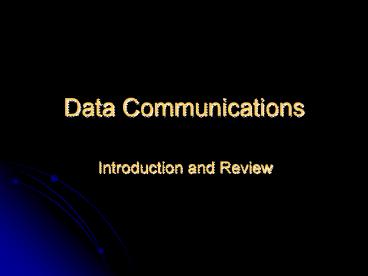Data Communications - PowerPoint PPT Presentation
1 / 16
Title: Data Communications
1
Data Communications
- Introduction and Review
2
Transmission Media
- Copper Wires
- Low resistance. Electrical signal produces
miniature radio station interference. - When one wire encounters another
electromagnetic wave occurs. - Interference has to be minimized in order for
communications to occur. - Twisted Pair
- Coaxial Cable
3
Transmission Media
- Glass Fibres
- Transmitter at one end uses a light emitting
diode (LED) - Receiver at other end uses light sensitive
transistor to detect the pulse.
Advantages No interference Reflect Inward Light
encodes more Travel over a single fibre
Disadvantages Special equipment to polish
ends Finding breaks is difficult
4
Transmission Media
- Radio Waves
- Radio frequency or RF
- No direct connection
- Cannot bend around the earth
- Can be combined with satellites
- Microwaves
- Electromagnetic radio wave beyond the frequency
used by Radio and Television - Do not broadcast in all directions but can be
directed. - Carry more information than RF transmission
- Cannot penetrate metal structures
5
Transmission Media
- Infrared
- Limited to small area
- Transmitter pointed toward receiver
- Inexpensive no antenna
- TV Remote
- Laser
- Similar to Microwave ie. line of sight
6
Asynchronous Communication
- Sender and receiver not synchronized
Parity Bit Stop Bit Parity Bit Stop
Bit
0 01000111 0 1 ?? 0 01001010 1 1
???????
Electrical signal transmitted does not contain
information the receiver can use to determine
where individual bits begin and end.
Start Bit ASCII G Start Bit ASCII J
7
Asynchronous Communication
- Using electric current to send bits
- Negative voltage could be used to represent 1
while a positive voltage could be used to
represent 0
8
Asynchronous Communication
Problem there is no set interval that a bit is
transmitted
Waveform Diagram
time
0
-
1
0
1
0
0
1
9
Asynchronous Communication
- Standards for communication
- How long should the sender hold the voltage on
the wire for a single bit? - What is the maximum rate at which hardware can
change the voltage? - How can users be sure that different vendors
hardware will be compatible?
10
Asynchronous Communication
- Standards for communication contd
- International Telecommunications Union ITU
- Electronic Industries Association EIA
- Institute for Electrical Electronics Engineers
- IEEE
11
Asynchronous Character Transmission with RS-232
- Standard by Electronic Industries Association
(EIA) - Connection less than 50 feet long
- Voltage range -15 to 15 volts
- Specifies transmission of characters
- Each character uses 7 bits
- Defines serial asynchronous communication
- Never leaves 0 volts on the wire
12
Asynchronous Character Transmission with RS-232
Sending and receiving hardware agree on the
length of time for transmission of a bit
15
time
0
-15
stop idle
Idle start
1 0 1 1 0 1 0
13
Asynchronous Character Transmission with RS-232
- Baud rate number of changes in the cycle per
second - bps
- Manufacturers make hardware to operate at various
rates - Framing errors can occur
- If voltages do not agree or the stop bit does not
occur at the time expected.
14
Asynchronous Character Transmission with RS-232
- Communication is full duplex.
T R G
T R G
A modem transmits on pin 2 and receives on pin
3, while a computer transmits on pin 3 and
receives on pin 2. The ground is pin 7.
The cable that connects a computer to a modem has
a wire from pin 2 to pin 2, pin 3 to pin 3, and
pin 7 to pin 7 for the ground.
15
Asynchronous Character Transmission with RS-232
- Real hardware is limited.
- Bandwidth and bit transmission.
- Measured in cycles per second or Hertz (Hz) .
Real
Ideal
16
The End.































